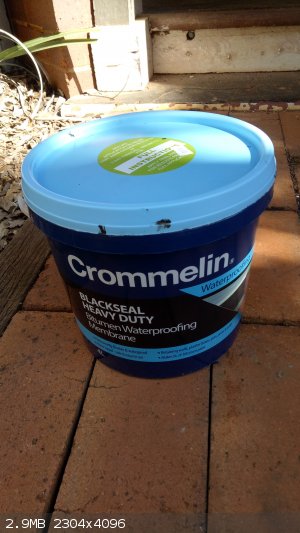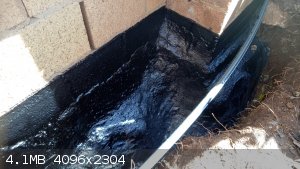j_sum1
Administrator
       
Posts: 6229
Registered: 4-10-2014
Location: Unmoved
Member Is Offline
Mood: Organised
|
|
Bitumenous Membrane – comercial product with unusual properties
This is mostly a question to satisfy my curiosity.
I am working with a product that is used to apply a waterproof coating to concrete / cinder-block / brick surfaces that are below ground level. (I am
using it for its intended purpose. I need to prevent ground water from seeping into a basement. Digging the trench was a PITA.)
This product is a thick tarry paste with approximately the consistency of toothpaste. For use it needs to be diluted 1:1 with water and applied with
a brush.
To my surprise, it blends really well with water. It forms a grey, greasy-looking mixture that is very fluid and applies easily like decking oil.
Brushes, containers and hands wash off easily with water.
However, when the product is dried, the material is a thick and tacky tar substance with a consistency exactly the same as road bitumen. This has no
affinity with water whatsoever. It will not wash off with hot water and detergent. Ethanol has no effect on it. But it is fully soluble in
gasoline.
It dries really rapidly -- at a faster rate than expected to evaporate 50% added water. I am not sure how much water is present in the tarry residue.
Anyway, my question. What is the composition likely to be for it to have such variant properties with respect to its affinity to water?
(I guess I could ask the same question of acrylic paint, but this product's tarry-ness takes it to a whole new level.)
|
|
|
Twospoons
International Hazard
    
Posts: 1282
Registered: 26-7-2004
Location: Middle Earth
Member Is Offline
Mood: A trace of hope...
|
|
Many years ago I used a product called "Mulseal" to seal cables into slots in tarmac. It was a bitumen - latex emulsion. Horrible stuff once dried -
rubbery tar, exactly as you'd expect. But water washable when still wet. We used it undiluted, as we were basically backfilling the cable slots and
wanted minimum shrinkage.
I imagine yours is something similar.
Helicopter: "helico" -> spiral, "pter" -> with wings
|
|
|
Tsjerk
International Hazard
    
Posts: 3022
Registered: 20-4-2005
Location: Netherlands
Member Is Offline
Mood: Mood
|
|
Could you mix a weighed amount with water and weigh again after drying? It would be interesting to see whether there still is water afterwards.
|
|
|
j_sum1
Administrator
       
Posts: 6229
Registered: 4-10-2014
Location: Unmoved
Member Is Offline
Mood: Organised
|
|
Quote: Originally posted by Tsjerk  | | Could you mix a weighed amount with water and weigh again after drying? It would be interesting to see whether there still is water afterwards.
|
That's a good idea. I may do that.
I will rake some pics and report back when I do.
[Edit adding pix]
Product

Product in use

[Edited on 17-7-2022 by j_sum1]
|
|
|
Fantasma4500
International Hazard
    
Posts: 1677
Registered: 12-12-2012
Location: Dysrope (aka europe)
Member Is Offline
Mood: dangerously practical
|
|
irking feeling that there may be some silicone in it? is there solvents in it? i tried getting the MSDS but they wont give that out, i found some
vague stuff saying theres no harmful chemicals in it (just like toothpaste)
would be cool if it could tolerate +100*C and all strong acids.... very cool indeed.
|
|
|
arkoma
Redneck Overlord
      
Posts: 1761
Registered: 3-2-2014
Location: On a Big Blue Marble hurtling through space
Member Is Offline
Mood: украї́нська
|
|
I can't find the exact same product now, but we used to use something similar to this:
https://www.homedepot.com/p/Henry-0-90-Gal-107-Asphalt-Emuls...
to seal up potable water tanks in the Mojave Desert. It was a brown mixture about the texture of yogurt and water soluble until it DRIED. Then it was
black and water proof, with no volatile petroleum products.
"We believe the knowledge and cultural heritage of mankind should be accessible to all people around the world, regardless of their wealth, social
status, nationality, citizenship, etc" z-lib
|
|
|
dome13
Harmless

Posts: 30
Registered: 29-6-2019
Location: Hungary
Member Is Offline
|
|
I work in an asphalt laboratory and we have a bitumen emulsion plant. My daily routine is to analyze an emulsion sample. We produce "cation active"
emulsion, which means it contains hydrochloric acid in water phase. The emulsion's pH is usually 2,0-2,3. It contains water in 40% and 60% bitumen. It
has a chocholate brown colour and a characteristic odour - for me, it's like somekind of organosulfur compound.
|
|
|
j_sum1
Administrator
       
Posts: 6229
Registered: 4-10-2014
Location: Unmoved
Member Is Offline
Mood: Organised
|
|
I hope to get into the lab this weekend. I will do some tests (which will probably take a bit of time). I will add pH measurement to the tests.
It really sounds like I won't get to the bottom of it all though. It seems we have an emulsion with an affinity for water -- which is what it says on
the box. Exactly how that emulsion works looks like it is a matter for research rather than experiment. Still, it seemed to me to be a rather
interesting product with quite strange properties.
FTR, the concrete wall is now fully sealed with several thick coats. It has dried to make an impermeable membrane. Drainage pipe is now in the
trench and it is back-filled with gravel. Job done. (Not sure if the tree I was digging around will survive. I had to cut away a lot of roots.)
|
|
|
j_sum1
Administrator
       
Posts: 6229
Registered: 4-10-2014
Location: Unmoved
Member Is Offline
Mood: Organised
|
|
I have done a couple of tests on this.
pH of the raw product is about 10 -- quite alkaline.
I also took weight measurements of the material before and after drying, with and without water added.
Dried mass was 45.9% less than the original starting material irrespective of whether water had been added. (Results were equal within measuring
tolerances.)
So, it seems that there is around 45% water and volatiles in the product and that it exists as an emulsion to which further water may be added. The
high pH may be a mechanism to achieve this. Once the water has evaporated, the emulsion has broken and the material becomes impervious to water. It
is still tacky and tar-like and so appears different from a paint. However, I guess it is essentially the same idea as an acrylic paint.
|
|
|